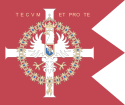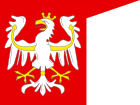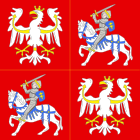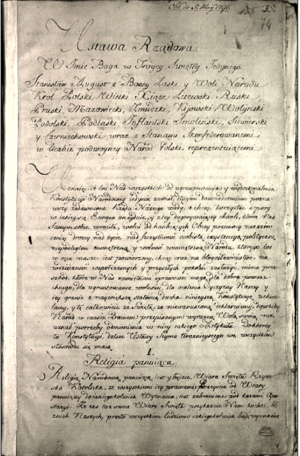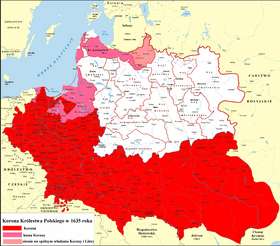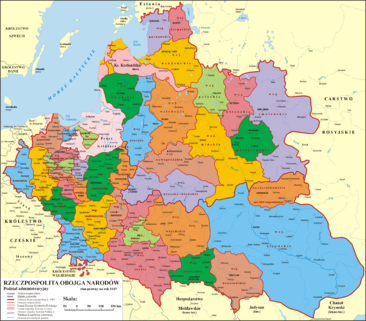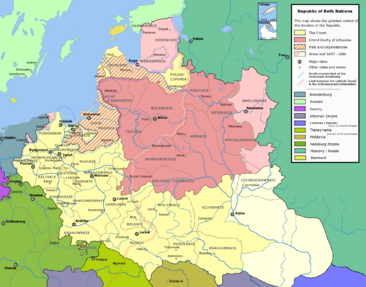Crown of the Kingdom of Poland facts for kids
Quick facts for kids
Crown of the Kingdom of Poland
|
|||||||||||||
|---|---|---|---|---|---|---|---|---|---|---|---|---|---|
| 1386–1795 | |||||||||||||
|
|
|||||||||||||
|
Anthem: "Bogurodzica"
"Mother of God" "Gaude Mater Polonia" "Rejoice, oh Mother Poland" |
|||||||||||||
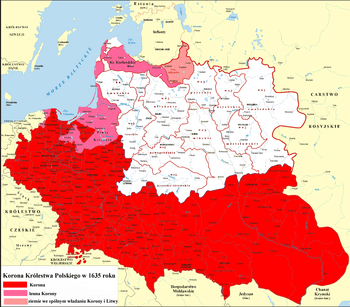
The Crown of the Kingdom of Poland (red) within the Polish–Lithuanian Commonwealth in 1635.
|
|||||||||||||
| Status | Part of the Polish–Lithuanian Commonwealth (1569–1795) | ||||||||||||
| Capital | Kraków | ||||||||||||
| Official languages | Polish, Latin | ||||||||||||
| Religion | Roman Catholicism (state religion) | ||||||||||||
| Government | Unitary parliamentary Elective constitutional monarchy | ||||||||||||
| Legislature | Sejm | ||||||||||||
| Senate | |||||||||||||
| Chamber of Deputies | |||||||||||||
| Historical era | Middle Ages Early modern Europe |
||||||||||||
| August 14 1386 | |||||||||||||
| 1 July 1569 | |||||||||||||
|
• May 3 Constitution
|
May 3, 1791 | ||||||||||||
|
• Third Partition
|
January 7 1795 | ||||||||||||
| Currency | Grosz | ||||||||||||
| ISO 3166 code | PL | ||||||||||||
|
|||||||||||||
The Crown of the Kingdom of Poland (in Polish: Korona Królestwa Polskiego) was a big idea that started in the 1300s. It meant that the country was a single, strong, and ongoing state. This idea changed how Poland was ruled.
Before, the country was seen as the king's personal property. But with the "Crown" idea, it became something that belonged to everyone in the kingdom. This helped Poland stay strong even when there was no king. It also led to a special system where nobles had a lot of power and could even choose their ruler.
The idea of the "Crown" also meant that lands lost in the past still belonged to Poland. This concept first appeared in countries like Bohemia and Hungary. Polish kings Ladislaus the Short and Casimir III the Great used it to make their rule stronger. Later, during times when Poland had no king or a very young queen, the nobles used this idea to show their own important role in running the country.
Contents
What was the Crown of the Kingdom?
The idea of corona regni (Latin for "crown of the kingdom") first appeared in England in the early 1100s. By the 1200s, it meant the king's power and rights that could not be taken away. It also meant the state itself, including its land, even if some parts were lost.
In the 1300s, the "Crown" became more important than the king. The king could not harm the Crown's rights or give away its lands. The Crown, which was once just a royal jewel, became a lasting legal idea. Similar changes happened in other European countries.
In Hungary, the idea of the corona regni was linked to the actual Holy Crown of Saint Stephen. This crown became a very important symbol. In Bohemia, the idea helped unite different lands under the Bohemian throne. This meant these lands were tied to the lasting "Crown," not just to the king at the time.
Key Moments in Poland's History
Poland's history as a state began around 966 AD. That's when Prince Mieszko I and his people, the West Polans, became Christian. This event, called the Baptism of Poland, created the first real Polish state. Later, Mieszko's son, Bolesław I the Brave, became the first crowned King of Poland in 1025.
The Union of Krewo
The Union of Krewo was a series of agreements made on August 13, 1385, at Kreva Castle. These agreements led to a personal union between Poland and Lithuania. This meant they shared the same ruler but kept their own laws.
Jogaila, the Grand Duke of Lithuania, agreed to these terms on August 14, 1385. He promised to become Christian and bring his lands (Lithuania and Russia) to the Polish Crown forever. After being baptized in Kraków on February 15, 1386, Jogaila became King Władysław. Three days later, he married Queen Jadwiga.
The Union of Lublin
The Union of Lublin created the Polish–Lithuanian Commonwealth on July 1, 1569. This was a "real union," meaning Poland and Lithuania became one single state. Before this, they only had a personal union (shared ruler).
The Union of Lublin also changed the Polish Crown into an elective monarchy. This meant kings would be chosen by election, not born into the role. This ended the Jagiellonian dynasty. The first elected king was Henry de Valois in 1573. He later left Poland to become King of France.
The Constitution of 1791
The Constitution of May 3, 1791 was a very important document. It was the second-oldest written national constitution in history, after the United States Constitution. It was also the oldest in Europe.
King Stanisław II Augustus was the main writer of this constitution. He wanted Poland to be a constitutional monarchy, like Great Britain. This meant the king's power would be limited by laws. The constitution was adopted on May 3, 1791. It gave more rights to regular citizens, divided the government into three parts (like the U.S. government), and stopped some old abuses of power.
The constitution made the king the head of the executive branch, working with his ministers. The law-making part of the government had two houses: an elected Sejm and an appointed Senate. This new law angered Catherine II of Russia. She believed Poland needed Russia's permission for any changes. Russia invaded Poland in 1792, and the constitution lasted less than two years.
How Poland was Governed

The idea of the Crown of the Kingdom of Poland was a big step for Poland. It showed that the Polish kingdom was separate from the king himself. This changed Poland from a patrimonial monarchy (where the king owned the country) to a "quasi-constitutional monarchy" (where power was shared). In this new system, the nobility, clergy, and even some working people had a say. It also became an elective monarchy, where kings were chosen.
Another important idea that came up was Rzeczpospolita, which means "Commonwealth." This became another name for the Polish state after the Union of Lublin in 1569. The Crown of the Kingdom of Poland was also linked to other symbols of Poland, like the capital city of Kraków, the Polish coat of arms, and the flag of Poland.
Geography of the Crown
The "Crown" also had a geographical meaning. It referred to the lands that were always part of the Polish Crown and could not be divided. These were the territories directly ruled by Poland from the Middle Ages until the late 1700s. Today, these lands are part of Poland, Ukraine, and some border areas of Russia, Belarus, Moldova, Slovakia, and Romania.
The term "Crown" also meant all the lands that Poland had a right to rule, even if they were not currently inside Polish borders. It helped separate the lands of the Polish Crown from those of the Grand Duchy of Lithuania. It also distinguished them from other areas that were like "fiefs" (lands controlled by a lord but owing loyalty to a king), such as the Duchy of Prussia and the Duchy of Courland.
Before the 1569 Union of Lublin, "Crown territories" meant the Kingdom of Poland itself, where most Poles lived. After the Union of Lublin, much of present-day Ukraine, which was previously ruled by Lithuania, became part of the Crown territory. During this time, a Pole from the Crown territory was called a koroniarz (Crownlander).
Sometimes, "the Crown" could also mean the king's personal power and wealth, separate from the government's power. This helped tell the difference between people loyal to the elected king and those loyal to powerful Polish nobles.
Provinces of the Crown
After the Union of Lublin in 1569, the Crown lands were divided into two main provinces: Lesser Poland (Małopolska) and Greater Poland (Wielkopolska). These provinces were then split into smaller administrative units called voivodeships.
Greater Poland Province
This province included many important areas:
- Brześć Kujawski Voivodeship (Brześć Kujawski)
- Gniezno Voivodeship (Gniezno)
- Inowrocław Voivodeship (Inowrocław)
- Kalisz Voivodeship (Kalisz)
- Łęczyca Voivodeship (Łęczyca)
- Mazovian Voivodeship (Warsaw)
- Poznań Voivodeship (Poznań)
- Płock Voivodeship (Płock)
- Podlaskie Voivodeship (Drohiczyn)
- Rawa Voivodeship (Rawa Mazowiecka)
- Sieradz Voivodeship (Sieradz)
- Prince-Bishopric of Warmia
Lesser Poland Province
This province covered the southern and eastern parts of the Crown lands:
- Bełz Voivodeship (Bełz)
- Bracław Voivodeship (Bracław)
- Czernihów Voivodeship (Czernihów)
- Kijów Voivodeship (Kijów)
- Kraków Voivodeship (Kraków)
- Lublin Voivodeship (Lublin)
- Podole Voivodeship (Kamieniec Podolski)
- Ruś Voivodeship (Lwów)
- Sandomierz Voivodeship (Sandomierz)
- Wołyń Voivodeship (Łuck)
- Duchy of Siewierz (Siewierz)
Royal Prussia Province (1569–1772)
Royal Prussia was a special area that was partly self-governing but belonged to the Polish–Lithuanian Commonwealth. It included important cities like Gdańsk, Toruń, and Elbląg.
Other Lands and Fiefs

The Polish Crown also had control over other lands, either directly or as "fiefs." A fief was a territory that was ruled by its own lord but owed loyalty and sometimes payments to the Polish king.
Principality of Moldavia (1387–1497)
Moldavia, a region to the southeast of Poland, had strong ties with Poland. In 1387, its ruler became a vassal of Polish King Władysław II Jagiełło. This meant Moldavia was a fief of Poland. Moldavia helped Poland in wars, and in return, Poland sometimes gave Moldavia control over certain areas. This connection lasted for about 110 years.
Towns in Spisz (Szepes) County (1412–1795)
In 1412, Hungary "pawned" 16 rich, salt-producing towns in the Spisz region to Poland. This was like a loan: Poland gave Hungary a large amount of silver, and in return, Poland could control these towns until the debt was paid back. The debt was never fully repaid, so Poland kept control of these towns for a long time.
Duchy of Siewierz (1443–1795)
The Duchy of Siewierz was sold to the Archbishop of Kraków in 1443. It became a special "church duchy" linked to the Lesser Poland Province. In 1790, it officially became part of the Polish Crown.
Prince-Bishopric of Warmia (1466–1772)
The Prince-Bishopric of Warmia was a semi-independent state ruled by a bishop. It was under the protection of the Kingdom of Poland after a peace treaty in 1466. It remained part of the Polish–Lithuanian Commonwealth until 1772.
Lauenburg and Bütow Land
This land became a territory of the Polish Crown in 1637. In 1657, it was given to the Hohenzollern family (who ruled Brandenburg-Prussia) as a fief. This was in exchange for their help against Sweden. It remained a Polish fief until 1772, when it became part of Prussia.
Duchy of Courland and Semigallia (Courland) (1562–1791)
This duchy in the Baltic region was a vassal state of the Grand Duchy of Lithuania and later the Polish–Lithuanian Commonwealth. It even had its own colonies in Tobago and Gambia for a time! It gained full independence in 1791 but was taken over by Russia in 1795.
Duchy of Prussia (1569–1657)
The Duchy of Prussia was a duchy in eastern Prussia. It was created in 1525 as a fief of the Polish Crown. This meant its ruler owed loyalty to the Polish king. In 1657, the Polish king gave the ruler of Prussia full control over the duchy. This was in exchange for his help against Sweden. This full control was important because it allowed the Duchy to become the Kingdom of Prussia in 1701.
Duchy of Livonia (Inflanty) (1569–1772)
The Duchy of Livonia was a territory that was shared by the Polish Crown and the Grand Duchy of Lithuania.
Protectorates
Caffa
In 1462, the city of Caffa asked Polish King Casimir IV of Poland for protection. This was because the Ottoman Empire and the Crimean Tatars were expanding. The Polish king agreed to protect Caffa, but when real danger came, help never arrived.
See also
 In Spanish: Corona del Reino de Polonia para niños
In Spanish: Corona del Reino de Polonia para niños
- Administrative division of the Polish–Lithuanian Commonwealth
- Lands of the Crown of Saint Stephen
- Lands of the Crown of Saint Wenceslaus


